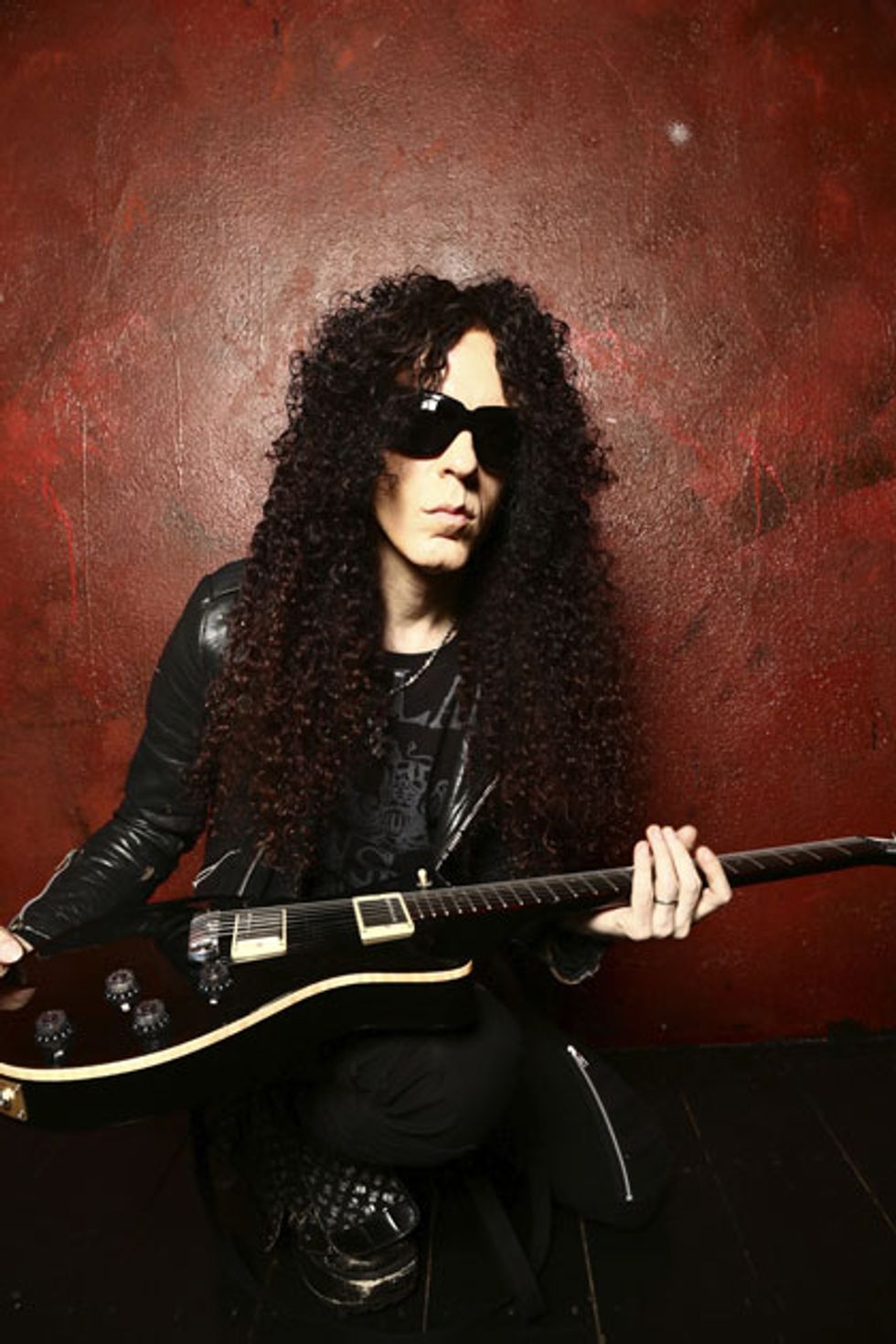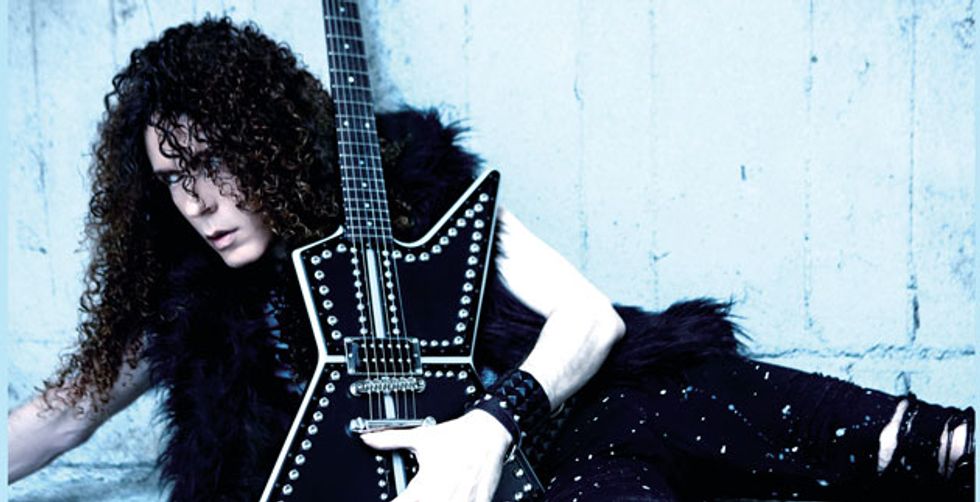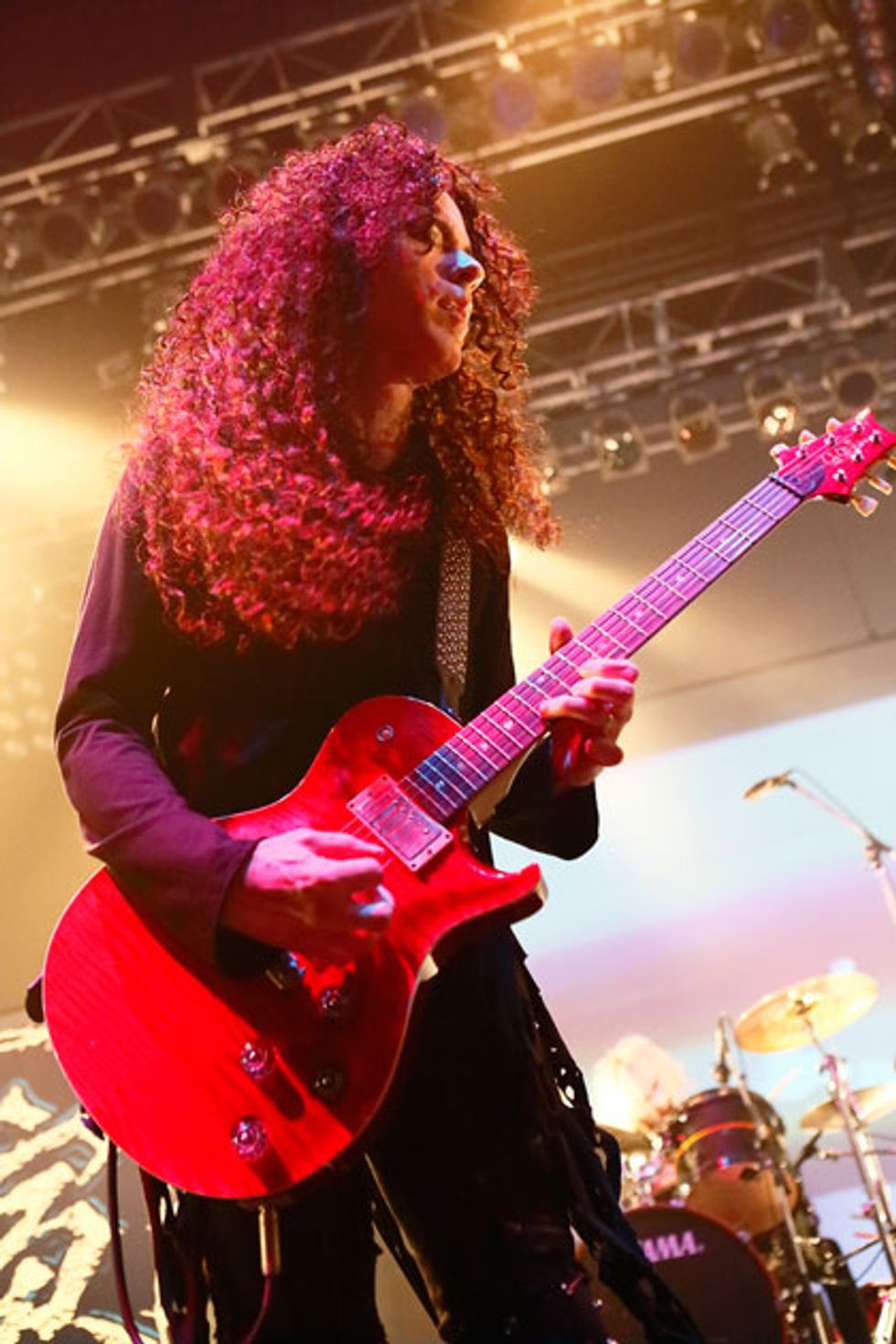The metal-shred hero returns with his first solo album in many years.
Ex-Megadether Marty Friedman, a longtime PRS player, recently launched a single-cutaway signature SE model.
For 10 years Marty Friedman basked in Megadeth’s bright white light. He virtually wrote the code for thrash metal guitar on the band’s early-’90s albums Rust in Peace and Countdown to Extinction, and to this day shredders regularly tout those records as touchstones. But the fame and hoopla turned sour, and Friedman simply walked away from it all. “I wasn’t reaching my full potential in that band anymore,” he says. “We’d be on tour and people would come up to me and say, ‘Oh, you’re in Megadeth—are they still a band?’”
Friedman retreated to Tokyo, where he’s lived and worked for the past decade—but not that you’d know it. He concentrated on the Asian music market, playing with Japanese pop artists and releasing solo albums. But the 51-year-old master shredder has returned with Inferno, his first guitar instrumental album since 2006’s Loudspeaker.
Even though he’s been away for some time, Friedman understood exactly what his fans wanted to hear. “They wanted to hear me play my friggin’ ass off,” he says. “They wanted to hear heavy, aggressive, innovative, and warped shit.”
And that’s exactly what the guitarist delivers. Engineered by Chris Rakestraw (Children of Bodom, Danzig) and mixed by Jens Bogren (Opeth), Inferno is Marty Friedman unleashed on a dozen tracks of blistering guitar. Owing to multiple rewrites, arrangement changes, edits, and simply Friedman’s meticulous attention to detail—which can meant burning down 100 takes of the same solo—the album took 14 months to complete. Working with the rhythm section of Skyharbor drummer Anup Sastry and bassist Toshiki Oomomo, the guitarist also called on friends like Children of Bodom’s Alexi Laiho, vocalist Danko Jones, Skyharbor’s Keshav Dhar, Rodrigo y Gabriela, and the Shining’s saxophonist Jørgen Munkeby to guest on selected tracks. There’s also an eerily beautiful song called “Horrors,” a writing collaboration with longtime friend and former Cacophony bandmate Jason Becker.
“I was going to take a long time to make the greatest album of my career,” Friedman says. “Do it with the love and respect all the people waiting for me deserve.”
Freidman told Premier Guitar about his experience making Inferno—and why he detests instrumental guitar music, doesn’t care about effects, and never really understood Jimi Hendrix.
Have you kept your finger on the pulse of American instrumental guitar music?
Absolutely not. I hate instrumental guitar music. Believe me, if someone did some instrumental music that set me on fire, I would love it. Unfortunately, I hear a lot of fantastic music, but nothing touches me.
Official track stream “Steroidhead”
I have the right to be a hypocrite! I don’t mind being lumped in with fantastic musicians even if they do instrumental music. But I think my music doesn’t even slightly sound like these other guys. My influences and the place I come from are so different from what the other guys do. I don’t think I have any of the same goals as a lot of my contemporaries. These guys love the instrument and the history of guitar. They idolize Jimi Hendrix, Jimmy Page, and fantastic musicianship, but I could really give a shit about any of that stuff, man.
Hendrix and Page don’t mean anything to you?
All these instrumental guys say the same types of things, like, “I love jazz, fusion, classical. Jimi Hendrix, and Eric Clapton.” These are indisputably fantastic things, but I fell in love with different things. I’m into current pop music from Japan and ’50s music like the early rock ’n’ roll and the doo-wop stuff. Girl groups, the Beach Boys, Phil Spector, and those types of melodic soundscapes. And super-intense and brutal, brutal death metal-type riffage.
Were you challenged in coming up with new and edgy guitar sounds?
I really don’t get into that because I don’t know about any of those things. The other thing is, I don’t have the time. I’m way too interested in the content of the music itself. The main direction I gave to my guitar tech was, “Get me a tone that any guy in a bar band would have.” I paid 99 percent of my attention to the content and the performance and one percent to getting sounds. Which is basically leaving it up to someone who knows what they’re doing.
How much of Inferno was improvised?
There’s quite a bit of improvising in the demo stage when I’m creating the actual shape of the song—where it’s supposed to go up and down and the basic flow. I often throw just anything down on the demo just so I know there’s supposed to be a solo there. When I’m recording the thing for real, I’ll do thousands of takes on one little section. The main meat and potatoes of everything is completely worked out and sculpted. In the very last stage, I have a lot of fun with stuff and just improvise like crazy.
Marty Friedman has been living and making music in Japan for the past decade. “I wasn’t reaching my full potential in that band anymore,” he says of his decision to quit Megadeth.
What guitars did you bring out for Inferno?
I’ve been endorsing PRS for the last three years, and I have a new PRS Marty Friedman model that just came out. I used about five different PRS guitars on this record. The one that got used the most became the prototype for my signature model. It’s just an ass-kicking and really great-sounding guitar.
What amps were you running?
Engl amps. They send me five or six amps, I switch from one to the other, and they all sound good. An important thing when switching amps is, if you’re the same guy playing rhythms and leads, you don’t necessarily want to go through the same amp, because the tones tend to blend. But within only one Engl amp, you can get a great variety of sounds. I used the Steve Morse signature for the majority of the solos and then a Powerball on some stuff.
Marty Friedman's Gear
Guitars
PRS SE Marty Friedman Model
Various PRS SC 250 models
Cole Clark acoustic
Amps
Engl Steve Morse Signature Model
Engl Powerball
Engl cabinets with 75-watt Engl speakers
Effects
Boss Chorus
Boss ME-80
Maxon Auto Filter
Strings and Picks
D’Addario .010–.046 (6-string)
D’Addario .010–.059 (7-string)
Dunlop Heavy picks
What about effects?
Wow, almost none. I used a Boss Chorus and these amp simulators I love to use when I’m doubling a rhythm. I’ll use the real amps for the main rhythm passage, and I’ll double it with an amp simulator with a really odd tone you wouldn’t expect to record with. I used this thing called a Maxon Auto Filter sometimes on solos, and that’s about it. I don’t really spend a lot of time on effects.
“Inferno” opens the album with those mournful lines.
The title track is based on that opening melody. A lot of people want to hear me totally play my ass off. That’s okay, but to fit my other criteria of pleasing me, it’s got to have a purpose. As far as showing off on guitar, I did that in spades when I was 18, and it’s not gonna turn me on so much right now even if I know that’s what people want me to do. I have to make it have a purpose and have those waves of excitement. It has to have a goal and a musical motif that actually gives you something of value.
Then you close the album with “Inferno (Reprise).”
You have to put a purpose in to make all of the flashy playing really have value. It’s almost structured like a classical piece: You have a theme, and then it goes through several different morphs with a lot of passages that hopefully lead you from one to the next.
“Resin” is another track that opens with a beautifully lyrical line. How do you develop those types of thematic phrases?
I’m constantly searching for new lines and motifs that somebody hasn’t already done—and I haven’t already done. To me the charm point of that piece is the very beginning and the end. They’re basically the same motifs, but at the beginning it’s like going into a damp, dark, musty cave of hellishness. You go through a bunch of stuff, and then at the end it takes you to a climax of noise before dropping you off the cliff into the next song. That is quite a challenging process, because it’s all about the way you’re made to feel from point A to point B.
How do you achieve that?
Making exciting beats that force people to feel a certain way, so by the end of the song there’s nowhere else to go except off the edge of the cliff. It takes a lot of living with demos and shaving things just right and a lot of experimentation. That’s a good example of the way I write.
Tell us about “Wicked Panacea,” the flamenco track you do with Rodrigo y Gabriela.
I knew if I was going to work with them, I would want to do something they’ve never done and I’ve never done. It’d be easy for me to bang a solo over one of their songs, and it would be easy for them to play acoustic guitar over one of my songs. I had them write a whole bunch of things I could loop and make sections out of. I took what I liked and created an arrangement out of what they sent me. By the time I finished with it, it didn’t really look much like what they originally sent. I wrote my own music around what I had of theirs, and hence you have something that sounds like the ultimate collaboration between the two of us.
Is that what you did for “Steroidhead,” your collaboration with Keshav Dhar from Skyharbor?
Not a lot of guitar players get onto my radar, but when I heard him I was like, “This shit is great. This guy’s going to be a star.” I’ve been in the guitar business for a long time and I’ve pretty much heard it all, but this was fresh. I wanted to have a song that was like if we were in the same band together. That’s his sound going through my filter and my arrangements.
“I Can’t Relax” is one of the vocal tracks with Danko Jones. Is your dynamic approach different on vocal and instrumental tracks?
The only thing that’s mentally different is you have a shorter space in which the guitar is the main instrument, which is really the way it should be. Let’s face it, no matter how unique or interesting your guitar playing is, it’s a challenge for a lot of people to listen to that much guitar. Some people are up for that challenge, and God bless ’em, I love every one of them. But myself? It’s more refreshing to hear a fantastic guitar passage in the middle of a great song with vocals. But my concept of playing doesn’t change no matter what I’m doing.
Your solo in “I Can’t Relax” is pretty insane!
The solo section I’m playing over is totally rock ’n’ roll, but what I’m playing is so demented and so non-rock ’n’ roll. It’s all these atonal concepts that have found their way over a totally rock ’n’ roll motif, and yet it doesn’t sound weird.
What vibe were you going for with “Meat Hook,” a sort of Captain Beefheart-style track with Jørgen Munkeby on sax?
Like I said before about instrumental music, you’ve got to do something really unique to excite me. Jørgen plays this absolutely perverted sax line, and it’s so cool. First of all, I’m not a big sax fan, especially in rock. If somebody told me there was this guitar player playing with a sax player, I’d be immediately uninterested. I managed to do a very, very heavy metal track with a whole lotta sax in it, and I have a feeling even the most hardened anti-sax metal fan will succumb to its coolness. I totally beat my fears on it, because I hate sax so much, but I find myself listening to this and loving it.
How did the duet between Alexi Laiho and Danko Jones on “Lycanthrope” come about?
Alexi is a great carrier of the metal torch. I think metal has been done to death for so many years, and there are so few things that are vital and exciting. A few things are, and what Alexi does is one of them. When he told me he wanted to join me on this record, I was excited and looking forward to coming up with something. I had him write a song with me, sing it, write lyrics, and play guitar. Danko came in and did a great heavy metal duet with Alexi. It’s one of the most aggressive songs on the album.
On “Undertow” you used the rhythm section of bassist Tony Franklin and drummer Gregg Bissonette. Did you deliberately make it softer?
As brutally heavy as I intend to make an album, there’s got to be one spot to give it a contrast. This comes quite naturally to me—the hardest thing is to not do five of those on a record. Maybe I’ll do a whole record of those someday, but this album was meant to be balls-out the whole way. It’s one of my favorite things to do, and you’ve got to have one for the girls out there.
YouTube It
“Stigmata Addiction” is a track from Marty’s 2006 album Loudspeaker. This live concert version from Japan is a compendium of his mind-blowing techniques, including stunning sweeps, ferocious finger vibrato, and Eastern-sounding scales. At 4:12 the track breaks down into a halftime groove that showcases Marty’s beautiful sense of lyricism and melody.
Did you co-write “Horrors” with Jason Becker?
There’s a scene in his movie [Not Dead Yet] where he’s working on a song with his dad. I asked him if he was using that song for anything because I liked where I thought it was going. I said, “Dude, let’s collaborate on something on my record,” and he was totally up for it. He sent me a bunch of stuff he had, including that piece from the movie, and I basically wrote the song with that in mind. I created an entire song like I did in the Cacophony days. It was like, “What would Cacophony be like if it had continued to evolve?” Jason’s stuff on there is just off the hook. I had to come to the party and create the ultimate Cacophony-esque opus without making it a nostalgia piece.
Was that difficult?
That might have been the most challenging piece on the record because people have a certain expectation from what we did together. I wanted to also make sure I made Jason’s parts sound like Jason, since it wasn’t him playing. He can’t physically play guitar now, so there are a few acoustic parts on the song that Jason had written that I had a guy named Ewan Dobson play. He’s much more of an acoustic expert than I am, and he took Jason’s playing the way I arranged it and played it to a tee. So it was just like I was sitting in the room producing Jason, but it was actually Ewan playing the stuff. What you get at the end of the day is Jason’s spirit completely coming through. This is what Cacophony would be like had we continued to evolve.
Is Inferno the record you’ve been waiting years to make?
I went over this thing so many times writing and editing that I just don’t see anyone disliking it. Of course, I don’t mind if someone does dislike it, because you can never control anybody’s taste. But I really don’t see anything that will turn off any of my previous fans who have found me from my solo music or Cacophony, Megadeth, or any of the things I’ve done in Japan. I really feel I’ve covered everything in there, and the main thing is, I satisfied my own criteria. I really couldn’t do a better record than this right now, to be honest with you.




